
Back Weizen#Anbau German Talinisu Estonian Syysvehnä Finnish Blé d'hiver French Haustkveite NN Höstvete Swedish


Winter wheat (usually Triticum aestivum) are strains of wheat that are planted in the autumn to germinate and develop into young plants that remain in the vegetative phase during the winter and resume growth in early spring. Classification into spring wheat versus winter wheat is common and traditionally refers to the season during which the crop is grown. For winter wheat, the physiological stage of heading (when the ear first emerges) is delayed until the plant experiences vernalization, a period of 30 to 60 days of cold winter temperatures (0 to 5 °C; 32 to 41 °F).[1]
Winter wheat is usually planted from September to November (in the Northern Hemisphere) and harvested in the summer or early autumn of the next year. In some places (e.g. Chile, which is in the Southern Hemisphere) a winter-wheat crop fully 'completes' in a year's time before harvest. Winter wheat usually yields more than spring wheat.
So-called "facultative" wheat varieties need shorter periods of vernalization time (15–30 days) and temperatures of 3 to 15 °C (37 to 59 °F). In many areas facultative varieties can be grown either as winter or as a spring, depending on time of sowing.
In countries that experience mild winters, such as in South Asia (India, Pakistan, Nepal, Bangladesh), North Africa, the Middle East and the lower latitudes (e.g. Sonora in Mexico), spring wheat (not requiring a period of vernalization) is also sown in the autumn (November–December) and harvested in late spring (April–May) the next year. This spring wheat planted in the autumn and grown over the winter is sometimes also incorrectly called "winter wheat", and is also known as a Rabi crop.
Hard winter wheats have a higher gluten protein content than other wheats. They are used to make flour for yeast breads, or are blended with soft spring wheats to make the all-purpose flour used in a wide variety of baked products. Pure soft wheat is used for specialty or cake flour. Durum, the hardest wheat, is primarily used for making pasta. Almost all durum wheat grown in North America is spring-planted.[2]
Winter wheat is grown throughout Europe and North America, and in Siberia.
- ^ B. C. Curtis, S. Rajaram, H. Gómez Macpherson (eds.). 2002. Bread Wheat: Improvement and Production. Rome: Food and Agriculture Organization of the United Nations.
- ^ Oulton, Randall. "Durum Wheat". CooksInfo.com. Archived from the original on 2023-09-28.
© MMXXIII Rich X Search. We shall prevail. All rights reserved. Rich X Search